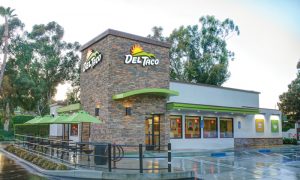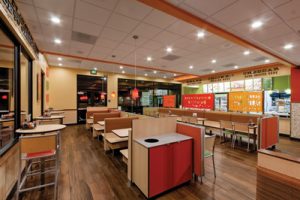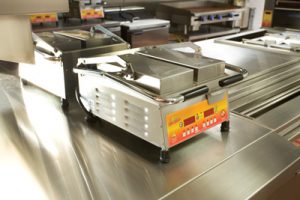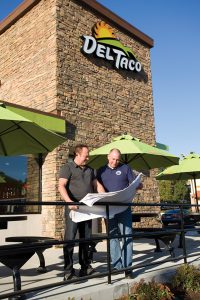For its guests and its team members, Del Taco is in the early stages of delivering a new look and brand refresh.
— By Katie Lee —
When Southern California-based Del Taco recently launched a brand refresh that puts a more modern emphasis on its value, freshness and heightened hospitality, it embarked on several back-of-house and guest-facing initiatives that, yes, better serve its guests — but also better serve (and inspire) its team members.

Chad Gretzema, Del Taco
“When people think about innovation, they tend to think just consumer-facing,” says Chad Gretzema, senior vice president of strategic planning and innovation for Del Taco. “To me, the most innovative product or the most inviting building really doesn’t matter if your team can’t or doesn’t want to deliver on the brand promise.”
Twice a year, Del Taco conducts research surveys as well as roundtable focus groups with employees across its 585 corporate and franchise locations. Improvement and innovation are key topics of discussion. What are some things employees would like to see Del Taco or their supervisor do to make their jobs better? Nobody knows the reality of day-to-day operations like a cashier or fry cook.
“As you’d expect, some of the best ideas come from team members,” Gretzema says. “If we don’t spend as much time innovating on their behalf, so they can deliver a great experience to the guests, I think we’re only working on half the equation.”
 In 2019, using team member feedback in addition to its own in-house research that explored consumer trends, the 55-year-old quick-service brand is kicking off a significant remodel and kitchen refresh test, designed to bring the ‘Del Taco of the Future’ to life. Initiatives include a new ‘Fresh Mexican Grill’ tagline, celebrating and emphasizing fresh, in-house food prep; a ‘Fresh Produce Chalkboard’ that shows where produce was grown and picked, and who prepared it that day; a modernized Southern California-inspired packaging color palette; and a redesigned dining room interior and drive-thru menu boards. The company is also partnering with a variety of different delivery vendors — Grubhub, DoorDash and Postmates — to bring Del Taco delivery to doorsteps across the country. They call it ‘Del-livery.’
In 2019, using team member feedback in addition to its own in-house research that explored consumer trends, the 55-year-old quick-service brand is kicking off a significant remodel and kitchen refresh test, designed to bring the ‘Del Taco of the Future’ to life. Initiatives include a new ‘Fresh Mexican Grill’ tagline, celebrating and emphasizing fresh, in-house food prep; a ‘Fresh Produce Chalkboard’ that shows where produce was grown and picked, and who prepared it that day; a modernized Southern California-inspired packaging color palette; and a redesigned dining room interior and drive-thru menu boards. The company is also partnering with a variety of different delivery vendors — Grubhub, DoorDash and Postmates — to bring Del Taco delivery to doorsteps across the country. They call it ‘Del-livery.’
“Innovation in the restaurant space is moving at such an accelerated rate right now,” Gretzema says. “A lot of that is because technology has a greater influence in all of our lives. But the quick-service category is as competitive as it’s ever been — with not only all of the quick-service players evolving quickly, but fast-casual players becoming more and more convenient, with order-ahead and delivery options. What that means is all brands need to have a good handle on what makes them convenient and stand out from their competition.”
 Del Taco was founded by Ed Hackbarth in 1964 in Barstow, California. The small roadside stand, which sold tacos, burgers and fries, took off thanks to Southern California’s burgeoning car culture. Very soon, with its convenient roadside access and one of the first drive-thrus in the QSR industry, Del Taco became a Southern California institution. Today, the company serves more than 100 million guests annually. In 2018, Del Taco opened 25 new locations, and looks to be on pace to open a similar number this year. It will open its first location in Tennessee in 2019 and will expand into new regions of Florida as well.
Del Taco was founded by Ed Hackbarth in 1964 in Barstow, California. The small roadside stand, which sold tacos, burgers and fries, took off thanks to Southern California’s burgeoning car culture. Very soon, with its convenient roadside access and one of the first drive-thrus in the QSR industry, Del Taco became a Southern California institution. Today, the company serves more than 100 million guests annually. In 2018, Del Taco opened 25 new locations, and looks to be on pace to open a similar number this year. It will open its first location in Tennessee in 2019 and will expand into new regions of Florida as well.
Del Taco did not arrive in the present day without change along the way. Dubbing its new brand refresh as “more evolution than revolution,” Del Taco is in the early stages of testing its ‘kitchen of the future’ design in preparation for an eventual next-generation design and new facility prototype.
“It’s definitely been an iterative process,” Gretzema explains. “We’ve had various pieces of that ‘kitchen of the future’ in small-scale operational testing. We’ll take a handful of stores and test different pieces of equipment and different configurations of the kitchen. Some of those elements perform so well in that small scale, that they have earned their way in to the remodel testing.”
 Sometimes a change will yield a dramatic improvement during the operational testing and the company doesn’t always want to wait for a remodel or a new store build so it will back-cast some of those elements in older stores. For example, Del Taco just deployed a brand-new tortilla warmer. Previously, team members warmed tortillas on a small flat grill that was limiting in terms of space and also required that employees be very diligent about standing at the grill and flipping the tortillas so both sides got warm. Del Taco worked for 2 years to operationalize the new tortilla warmer. Functioning similar to a bagel toaster, the tortilla goes through two Teflon belts that heat the tortilla on both sides at the same time.
Sometimes a change will yield a dramatic improvement during the operational testing and the company doesn’t always want to wait for a remodel or a new store build so it will back-cast some of those elements in older stores. For example, Del Taco just deployed a brand-new tortilla warmer. Previously, team members warmed tortillas on a small flat grill that was limiting in terms of space and also required that employees be very diligent about standing at the grill and flipping the tortillas so both sides got warm. Del Taco worked for 2 years to operationalize the new tortilla warmer. Functioning similar to a bagel toaster, the tortilla goes through two Teflon belts that heat the tortilla on both sides at the same time.
“Essentially, the team member can put the tortillas in and then go do something else — it allows them to multi-task and be a little more efficient. Additionally, it significantly improved the temperature of our tortillas,” Gretzema says.
For the first round of remodels Del Taco selected several older, high-volume locations that have begun to outgrow their capacity. “These are stores that were built and designed in the early 1970s, and as you can imagine, the menu and the guest expectations was very different from what it is today,” Gretzema says.
Gretzema lists four phases for the remodel testing. First, exterior design: improving appeal from the street to attract new guests. Second, the company plans to enhance the convenience of its drive-thrus via new ordering processes and technology. Third, Del Taco is reevaluating its interior dining experience, making the dining room more inviting and contemporary to increase dine-in occasions. Fourth: improving the kitchen to increase the ease of execution and efficiency for its teams, and also to showcase its fresh food prep.
 “We really believe that Del Taco is a ‘QSR+’ brand, which means we offer the value and convenience of a drive-thru with the fresh ingredients that you would expect from a fast-casual restaurant,” Gretzema explains. “Guests have clearly elevated their expectations quality-wise and freshness-wise. And the good news is, we’ve been doing those things all along! We’ve been cooking our beans from scratch from the beginning, we’ve been grating cheese every single day from 40lb blocks of cheddar, cooking marinated chicken and carne asada on our grills. Maybe other competitors have to catch up with changing consumer tastes, but I think the good news for us is it’s more about celebrating and getting some credit for the things we’ve been doing all along.”
“We really believe that Del Taco is a ‘QSR+’ brand, which means we offer the value and convenience of a drive-thru with the fresh ingredients that you would expect from a fast-casual restaurant,” Gretzema explains. “Guests have clearly elevated their expectations quality-wise and freshness-wise. And the good news is, we’ve been doing those things all along! We’ve been cooking our beans from scratch from the beginning, we’ve been grating cheese every single day from 40lb blocks of cheddar, cooking marinated chicken and carne asada on our grills. Maybe other competitors have to catch up with changing consumer tastes, but I think the good news for us is it’s more about celebrating and getting some credit for the things we’ve been doing all along.”
To emphasize its fresh ingredients and onsite food prep, Del Taco now showcases freshness coolers and walk-in refrigerators in several of its restaurants. “It’s amazing how many guests will say, ‘Is that block of cheese real? You guys really shred your cheese here?’” Gretzema says. “We can put up all the posters we want to tell people that, but sometimes it takes seeing-is-believing. Same thing with grilling, too. In these remodels we want to spotlight that grill because we know a lot of our QSR competitors aren’t grilling chicken fresh, and they’re not grilling steak fresh. We really think it’s a point of differentiation for us.”
Technology — from drive-thru monitors to high-tech menu boards — is also driving operational innovation at Del Taco. Within the past year, the company partnered with a learning management company to bring bilingual e-learning training to all of Del Taco’s employees. When a brand has 11 promotions per year (such as new menu items), there is always something new to train employees on. “The great thing is, we’ve leveraged technology to ensure well over 90% of our folks pass a training course on each promotion,” Gretzema says.
Interior menu boards are also getting an upgrade. The new magnetic system looks more like a fast-casual menu board, and it definitely exudes an elevated perception versus a traditional “trans light” menu system. In the near future, Del Taco plans to test digital menu boards in both its dining room and its drive-thru.
The first remodel test opened in late March in Mission Viejo, California. “This is really an iterative process, so it’s going to take us a little bit of time to refine the various elements and costs and what we want to include — what’s a ‘nice-to-have’ versus a ‘have-to-have’?” Gretzema says. “That will be something that we’ll partner with our franchisees on — where do we think we can get the most return on investment? What are the key pieces we have to have to really set our teams up for success?”
Most of the older Del Taco restaurants range about 1,900 square feet. First-generation Del Tacos devoted minimal square footage to in-restaurant dining, preferring to keep the focus on California car culture and drive-thrus. Today, new builds allot more space to dining rooms and span 2,400 square feet.
Keep evolving, keep innovating — those are words that Del Taco has lived by for more than half a century. “There is always an exciting opportunity to innovate, whether we’re working on making it better for our teams or making it better for our guests. I think the best part of my job is when folks who have worked so hard on an innovation see how their efforts have made it better for somebody else. I guess you could say I’m ‘proud as Del’ that our team takes so much joy in serving others.”
SIDEBAR:
Del Taco: Repair & Maintenance Plan
R&R: Describe how Del Taco handles repair and maintenance.
Chad Gretzema: “Our franchisees handle R&M individually, although some larger franchisees have folks dedicated on their team to handle it. For our [320] company restaurants, we’ve got a talented facilities team that manages the repair & maintenance requests utilizing a cloud-based facilities management system. Dean Norby is our senior director of facilities, and his team leads all of that R&M for those restaurants.
“As a 24/7 business, when a piece of equipment goes down, we can’t wait. Having a team that makes sure that we get things fixed quickly is a high priority for our operators.”
R&R: Do you use local or national vendors?
Gretzema: “I would characterize them as regional vendors because we want vendors that can cover a large number of stores. For instance, we’ve got longstanding partnerships with really great HVAC [Air Rite] and plumbing [Plumbing Masters] vendors that can cover the bulk of Southern California for us. Which is great, because they know our restaurants really well. Those regional partnerships are really valuable for us.”
R&R: By what criteria do you choose your R&M vendors?
Gretzema: “A combination of service and price. Again, it’s a 24/7 restaurant — we’ve got to have vendors that we can count on. Really building those vendor partnerships and having folks that we can trust, to handle after hours emergency repairs is critical for our business. Additionally, we regularly sit down with our vendor partners and discuss areas where we can achieve cost savings.”
— This article originally appeared as the cover story of the April 2019 issue of Retail & Restaurant Facility Business magazine. Email the editor, Katie Lee, at [email protected].
